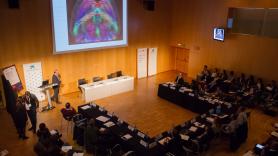1. From imaging techniques to molecular medicine
In 1949, chemist Linus Pauling and his team published a seminal study, establishing that a certain type of anemia was caused by specific alterations in the hemoglobin. This was the first time an abnormal protein was directly tied to a disease, meaning it was the beginning of what is now known as molecular medicine.
Nowadays this concept is commonplace, but scientists are still working to perfect it. According to Markus Rudin, professor at the University of Zurich, “In order to improve it, we need molecular diagnostic tools, and some of them have to do with molecular imaging.”
The first widespread imaging technique was the x-ray. After that came ultrasounds, MRIs, tomography and, most recently, PET (positron emission tomography). This last technique uses positrons emitted by a specific compound to locate, for example, cancerous areas based on their higher glucose consumption.
Precision and differentiation increase progressively, but little by little research is being done with new techniques that provide an even more concrete, much more specific image. For example, fluorescence is being used in combination with selective molecules to identify and observe specific molecular targets. Computer models are designed to recreate three-dimensional structures from flat images and tools are being developed using nanotechnology to identify the properties of a single cell within a cell conglomerate.
The applications of these techniques can be used in many different fields. One in which quite a lot of work is being done is cancer, but they would also be useful in improving some aspects of Alzheimer’s. For example, diagnosis of this disease is currently confirmed with a PET scan. Although, as Rubin explained, “That doesn’t work for prognosis. We’re working on different types of technology to observe both metabolism and inflammation, which have a better correlation with the progress of the disease.”
Rubin’s team is working on brain imaging techniques, in their case using mice. “We’re in the brain decade,” he said. “There are huge projects in Europe, the United States and Korea that are all trying to explain how it works.” In his case, the use of animals in research is justified for several reasons: they serve as a model of the disease, their neurotransmitters work in a similar way to those of humans, and they can fine-tune the results from functional magnetic resonance imaging. In this case, it is assumed that the increase in blood flow the technique captures shows that this region is working. But this correspondence isn’t necessarily mathematical and unequivocal. “Animal studies allow us to look at this relationship,” explained Rubin.
Another area in which imaging is gaining importance is drug research.
In computer science, according to Moore’s law, the number of transistors in a processor doubles every two years. “Unfortunately, drug development doesn’t follow this law,” said Oliver Plettenburg, director of the Institute of Medicinal Chemistry in Munich. In fact, “The number of drugs developed is decreasing, as is the amount of money invested. In 2016, only 19 were approved.”
The majority tend to fail in the final stages of development, in general due to lack of efficacy when tested in clinical trials, despite having shown promise in the laboratory. “We don’t understand the illness enough, or we underestimate the heterogeneity of patients,” said Plettenburg.
“Greater visibility of drug action in the early stages could help weed out ineffective drugs, or understand who they would benefit. For example, for patients with diabetes or atherosclerosis certain drugs may only be useful in specific stages of the disease.”
There are several techniques being developed to improve drug research. For example, work is being done on methods to show how they occupy their targets inside the cell. “This would allow us to assess the efficacy and side effects, adjust the dosage depending on the fraction of receptors occupied at any time.” Work is also being done to monitor chemical reactions, with fluorescent molecules given off that can be seen as the reaction occurs.
Some of these reactions are those carried out by what is known as cathepsins, proteins that destroy other proteins. Their function is important in pharmacology, as they are responsible for activating some drugs. But they are also essential to the cell: they participate in immune response, inflammation and even the creation of blood vessels. Changes in how they work can be seen in numerous diseases. One of these is cancer, where they can be key in the spread and metastasis of the diseases, by “breaking” the tissue surrounding it and allowing it to spread.
Visualizing and modifying cathepsins is the focus of the working group led by Boris Turk, professor of Biochemistry at the University of Ljubljana and one of the leaders of this B·Debate with Francesc Xavier Avilés, professor and group leader at the Autonomous University of Barcelona and the Institut de Biotecnologia i Biomedicina. The focus of Turk’s work is twofold. On one hand, they are locating excess cathepsin activity using fluorescent molecules. On the other, they also incorporate a photosensitizer, a molecule that makes the cell sensitive and susceptible to light. This allows them to combine diagnosis and treatment, locating the tumor and treating it specifically all with the same tool. It is what has been called "theranostics", and it is one of the approaches to cancer currently being studied.



